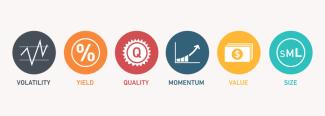
Factor Investing
Factor investing is a strategy for portfolio asset allocation that moves away from the traditional market-cap weighted approach towards alternative weightings (based on factors) with the goal of improving investment performance and portfolio diversification. In this framework, the portfolio building blocks are factors, rather than asset classes. Factors can be viewed as characteristics of stocks that are used to explain their underlying risk and price return performance. The theory behind factor investing is that the performance of any portfolio of stocks is directly related to a small number of factors, so the investing process can be improved by isolating and focusing on those very same factors. When we organize a portfolio along the lines of underlying risk we get a better understanding of how the trade-off between risk and return impacts investment performance. The strategy is simple enough….as we build a portfolio, we overweight stocks that rank high on a certain factor and underweight stocks that rank low on that factor.
We view stock factors as either defensive factors (low volatility, quality and dividend) or cyclical factors (momentum, value and size). While low volatility and dividend are self-explanatory, a quality factor is based on the financial strength of a company using metrics like return-on-equity, earnings stability, balance sheet strength and financial leverage. Momentum stocks exhibit a persistence (or provide an identifiable trend) to outperform other stocks, which tendency is based on 12-month relative returns and the perception that investors sometimes initially underreact to improving fundamentals and company trends. Often it is not until a stock is outperforming that it gains broad investor attention. Value investing targets companies with lower-than-average growth rates for sales and earnings and lower-than-average price-to-earnings (P/E) and price-to-book (P/B) ratios. With value stocks we are often looking at disappointing past results. In some cases, the period(s) of poor performance are considered temporary and suggest that a turnaround opportunity may exist. When a portfolio is based on a size factor, all companies selected are equally weighted, in contrast to the more traditional method of market cap (large, medium and small) weighting. Factors can be used to construct a full range of risk profile asset allocation models including conservative (using quality and low volatility factors), income oriented (dividend and value factors) and aggressive (momentum and size factors).
While factor analysis offers great insight to investors, it is not without its challenges. For example, there is no universal agreement on what factors are most important in predicting stock price performance. The right factor to consider depends on what questions you are trying to answer. Once factors that best drive risk and return are identified, exposures can be measured on an ongoing basis to ensure a portfolio is best structured to take advantage of those factors. Over time different factors tend to outperform in different market environments. While returns for the most widely used factors (see above) have proven to be consistent over time, it is noted that those returns show a wide degree of variation across all factors. In addition, while single factor strategies have often outperformed the broader market, that there have been long periods in which they underperform. Factor performance tends to be cyclical and most factor returns are not highly correlated, a condition with suggests that combining multiple or blended factor strategies might improve portfolio diversification. The cyclicality of factor returns may suggest to investors an opportunity to time their exposures – beware, however, as factor timing can be far more difficult than market timing!

